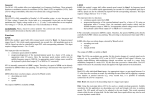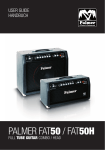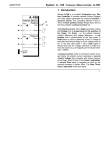Download General Set-Up Functions Cutoff Resonance
Transcript
General Cutoff The 24dB VCF module (Voltage Controlled Filter) is a low pass filter using the famous filter cascade invented by Bob Moog. However, this filter is not meant to be a 100% copy but offers its individual sonic fingerprint. The filter’s cutoff frequency can be controlled manually or via CV-inputs. Input CV1 with attenuator is meant for standard modulations by an envelope generator. 24dB VCF is fully compatible to Doepfer’s A-100 modular system - in size, bus-power and CV/Gate voltage. Connect the 16-pin cable to a corresponded 16-pin jack on the Doepfer mainframe bus or the MIDI/CV circuit board. Supply voltage needs to be +/- 9-12 volts, 5-volt connections are not required. The wattage is +/- 30 mA, the module size 8 TE (Teileinheiten) or 40 mm. CV2 has two functions: • It carries the mainframe/system Key-CV bus information (as applied from a MIDI/CV-interface or a bus-access-module). This allows direct keyboard tracking of the cutoff frequency. Tracking-intensity is set with the trim control CV2/Key. • The front panel input CV2 allows a second control voltage to be used for cutoff modulation, e.g. from a LFO. Here, the modulation intensity is set with trim control CV2/Key. ATTENTION: Please, check for correct polarity! The colored side of the connector-cable needs to point downwards so that the cable is not twisted. A jumper on the module’s back sets or disables internal wiring. Disconnection from the mainframe bus will allows independent use of the CV2 input. Functions Resonance A few words on the basic principle of a filter: The filter receives audio from oscillators, a noise generator or any other signal at its audio input. The cutoff control will now manipulate the signal’s harmonics content. Since 24 dB VCF is a low pass design, turning the cutoff control counterclockwise will reduce the amount of harmonics present in the output signal. Resonance pronounces the filter’s working point, resulting in the typical analog filter sound. Control voltages (CV) can modulate both parameters. The signal then reaches the audio output where it is routed to additional sound design tools or directly to the amplifier (VCA). In reminiscence to Moog’s filter cascade, the resonance control is named Emphasis. Emphasis can be either controlled manually or by CV applied to input CV Emp with corresponding attenuator. With Emphasis set higher than six (this value could slightly differ between modules due to component tolerance) the filter starts self-oscillating. Without any signal applied to the input, the filter generates a sound that is close to a sine wave. This sound’s pitch is controlled by the cutoff frequency. With cutoff under Key-CVcontrol, this sound is even playable to a certain extent. However, the filter is not as precisely controllable as an oscillator. The 24dB VCF module has two audio inputs. Input In1 offers a corresponding attenuator, while Input In2 has fixed sensitivity that matches the summed output of OSC-01 and OSC-02 modules. Input In1 is internally prewired to the filter output. With In1 not being patched, its attenuator controls filter feedback to supply additional bass punch. Hint: Create nice analog percussions using a self-oscillating filter. Many classic analog drummachines use self-oscillating filters instead of VCOs. For this, the cutoff frequency needs to be controlled by a fast envelope generator (short decay, low sustain level). Additional coloring can be applied by mixing in filter-FM (modulate the filter with an oscillator or a fast LFO). Set-Up Operating Manual 24dB VCF Module











